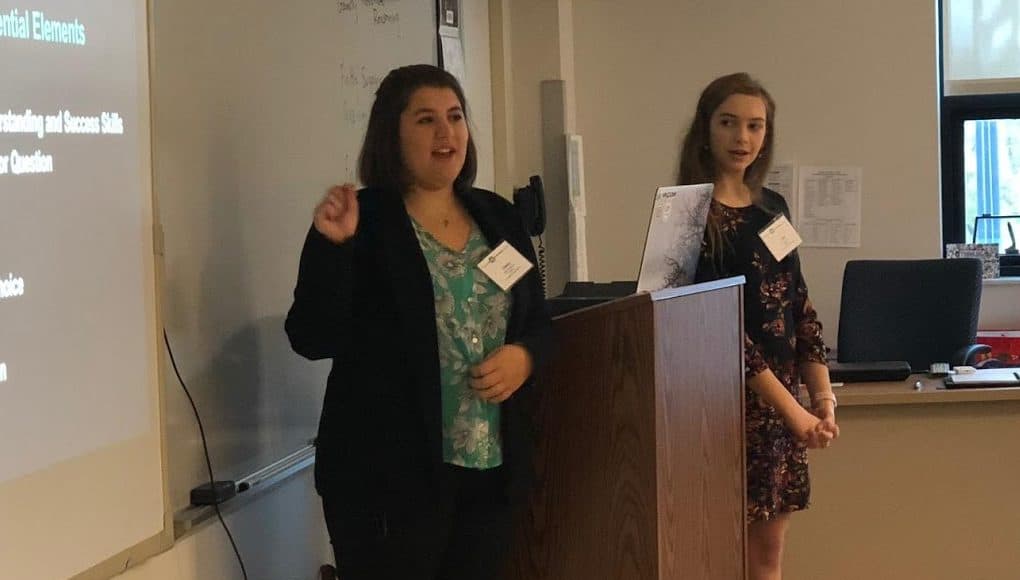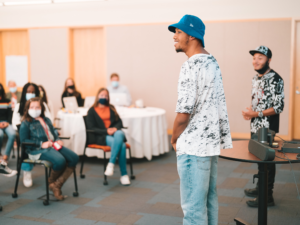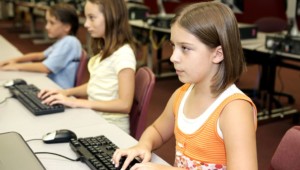The Future of Work: How Do We Prepare Our Students?

Although we cannot predict with certainty the types of jobs that will exist in the future, we know that today’s students will need a variety of skills, “21st century skills.” However, these are skills that our students need today. Knowing this, we must ask ourselves what are the best ways to provide all students with authentic, unique, and innovative learning experiences that will foster the development of these essential skills? How can we prepare students for jobs which may not exist yet in our ever-changing world?
As an educator of 25 years, I have seen a lot of changes in education. Popular discussions in learning communities focus on teaching methods, the classroom “space,” homework and grading policies, and whether students need a college degree to be successful in the future. When I was in high school, attending college was the natural progression after graduation for most students. My high school had students divided into different tracks: business, college prep, and vo-tech. Within each track, students followed a specific course of studies, with little room for “electives.” The goal was to prepare most students for college or entering the workforce after graduation. To do so, meant following a standard curriculum.
Looking at the changes we have seen in the areas of education and work, I think the best action we can take is to offer specific types of learning experiences for all students. If we provide ways for them to more actively learn and explore the world, then hopefully, and ideally, no matter what they ultimately decide to do, they will have skills, real-world awareness, and flexibility that will have them well-equipped for a constantly changing system.
Learning: How Can Students Learn Best?
In a speech about the future of learning, Alan November, international keynote speaker and author, said we have to “teach students how to learn.” I have often noticed when students are given an open-ended task to complete, rather than a traditional assignment or assessment, they have a lot of questions and give “I don’t know” responses. Students have become used to being able to find one right answer to questions. To best prepare them for the future, we have to help them develop the persistence to push beyond basic recall of content and instead engage in productive struggle and deeper levels of thinking.
A recent article listed five essential Montessori conditions for creating an innovative workplace. The conditions are:
- Dedicating time for creative projects,
- Rewarding innovation and divergent ideas,
- Empowering employees to make decisions,
- Allowing for failure, and
- Measuring what matters most.
I think that these conditions should be fostered in the learning environment we create for and co-design with our students. There are different school structures, programs, and teaching strategies that would align well with these essential conditions and provide students with the right preparation and skills for the future, now. If we provide more innovative learning opportunities for all students to build independence and have more choices in how and what they are learning, it will lead to better content retention and higher student engagement. Students will begin to see learning as a process, rather than a finite learning experience. I believe that these five types of learning experiences would facilitate this transition.
1) Project-based learning. With project-based learning (PBL), students develop the skills to work independently or collaboratively, to come up with an essential question that does not have an easily found or specific answer, and which engages students in sustained inquiry. PBL promotes critical thinking, creativity, and problem-solving, and enhances the learning potential for each student as they design their own learning path. Students need more real-world experiences, where they can assess needs in their community and brainstorm ways to effect changes that will positively impact others beyond their classroom walls.
In my Spanish courses, I chose to implement project-based learning because it created more independent, student-driven learning. It broadened cultural awareness as we connected globally with students in Spain and Argentina and interacted with one another using different digital tools and sharing our experiences. Each student group has questions and curiosities, and through these authentic connections, we give our students an opportunity to learn about life beyond their own school and community. When students have the opportunity to create something of personal interest and to experience productive struggle when seeking answers to challenging questions, we better prepare them for an uncertain future of learning and work. An additional benefit is that students can then share their learning in the community or even at tech showcase events or professional development for teachers, to show the benefits of PBL from their perspective.
2) Artificial intelligence. Several schools in the country are now offering courses in AI. In Pittsburgh, the Montour School District launched the country’s first middle-school AI program in 2018. During the opening showcase event, Justin Aglio, Director of Innovation for Montour, stated that approximately 40% of the jobs in the future will be replaced by artificial intelligence. With that being the prediction, students would benefit by learning about artificial intelligence and discussing the ethics surrounding its use. Students can learn how to use AI for good, become problem designers and create their own AI, rather than possibly being replaced by AI in the future of work. By giving all students the opportunity to understand, explore and design AI, we will foster innovation and provide all students with experiences and competencies that prepare them for the changes that AI might bring.
3) Maker education and coding. There are many ways students can develop skills for the future in coursework related to a STEAM curriculum or courses focused on coding. These experiences should be available for all students during their K through 12 education. Having opportunities to explore new technologies can lead students to discover their personal interests and experience more meaningful learning. Students can figure out what they may be interested in, become curious for learning, engage in hands-on learning, problem-solving, and troubleshooting. Classes which blend in STEM or STEAM curriculum will build the core skills that students need, especially when it comes to technology. We need students to understand how things work, how to iterate and design new technologies. Even in a world where there are countless apps available, many of which complete complex tasks, we still need humans to keep our technology relevant and competitive.
4) Place-based learning. According to a recent Getting Smart post, place-based learning is “anytime, anywhere learning that leverages the power of place, and not just the power of technology, to personalize learning.” For example, in place-based learning, we shift learning from the traditional content and instead look at a specific geographical area or focus on the culture of a place, to help students build on content knowledge while also developing empathy and social-emotional learning skills. Schools collaborate with local experts, businesses, community centers and other organizations to give students an opportunity to apply the content they are learning in the real world. These opportunities foster student agency, inform students about local and global issues, and facilitate a personal investment in their work.
When schools have their community become the classroom, it leads to higher student engagement and broadens student understanding and perspectives of the world they live in. Opportunities to engage in this hands-on learning not only builds rapport in the school community, but it gives students authentic, real-life work experience and a deeper level of understanding. They can see how the world works, look for challenges and be a part of the solutions.
Students could volunteer at community centers, travel to rural areas or even to a city to identify and solve problems like cleaning up the environment, starting a recycling program, planting a garden, or just talking with people to determine the issues that are affecting the community.
5) Entrepreneurial skills and courses. In learning more about the gig economy and the skills that students need for the future, a key takeaway was that students need to be able to quickly adapt to a changing work landscape. We need to offer students a course, or at least part of the curriculum within a course, dedicated to providing the right learning experiences where students can work independently as well as collaboratively. Entrepreneurial courses will foster critical thinking, problem-solving and time management skills as well as lead to other benefits. Students will develop social-emotional learning (SEL) skills by engaging in projects with a team to plan events, to set up a business, to create websites and manage a social media presence.
Students need to know how to leverage technology and have the right digital skills that will prepare them for a variety of work environments, whether physical or virtual. With the increase of technology use and platforms for business operations, companies are reducing the number of full-time employees and instead, hiring temporary employees or independent contractors, and in some cases, working in virtual spaces, requiring even fewer employees in a physical work space. We need to help students think like entrepreneurs, and become the innovators of the future.
There are courses and even digital resources that can help.
- Stukent offers courses and simulations for high school and higher education. Students can explore marketing, social media for business, and even interact with experts in business fields.
- Ever-Fi offers different programs and resources to provide students with exposure to STEM careers, business planning and career readiness.
- “Shark Tank,” following the tv series, offers students the chance to build skills through brainstorming, goal setting, time management, and teamwork. There are even board games that can push student thinking to an entrepreneurial mindset.
Activities like these, or planning large scale events like community days, school open houses, family nights, or even sporting events, can give all students a solid foundation for how to manage projects, create their own business and find success. More importantly, it fosters peer collaboration and relationship building that we all need to be successful and supported in our work.
Designing Different Experiences
As educators, the best that we can do is to keep ourselves informed of how the future of education and the future of work are changing. Staying informed means knowing what the job market looks like, what skills our students need, and how we can help them to develop those skills. We have a responsibility to all students because they will be designing our future. We need to design learning experiences that will prepare them to become the leaders, designers, problem solvers and innovators.
For more, see:
- Motivating Young People to Pursue the Professions of the Future
- How AI Curriculum Can Prepare Students for Success in a New World
- What if Students Designed Their Education?

This post is a part of the Getting Smart Future of Work Campaign. The future of work will bring new challenges and cause us to shift how we think about jobs and employability — so what does this mean for teaching and learning? In our exploration of the #FutureOfWork, sponsored by eduInnovation and powered by Getting Smart, we dive into what’s happening, what’s coming and how schools might prepare. For more, follow #futureofwork and visit our Future of Work page.
Stay in-the-know with innovations in learning by signing up for the weekly Smart Update.







suhani kishnani
This blog underscores the crucial role educators play in preparing students for the evolving landscape of work and society. By staying informed and designing innovative learning experiences, teachers can empower students to become future leaders and problem solvers. It's a call to action for educators to embrace change and cultivate the skills needed for success in an ever-changing world.